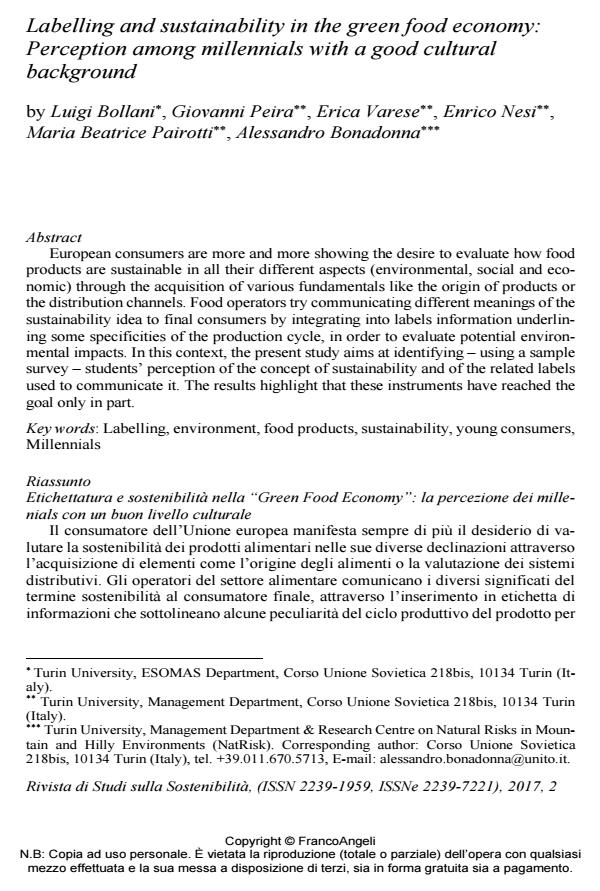Labelling and sustainability in the green food economy: Perception among millennials with a good cultural background
Journal title RIVISTA DI STUDI SULLA SOSTENIBILITA'
Author/s Luigi Bollani, Giovanni Peira, Erica Varese, Enrico Nesi, Maria Beatrice Pairotti, Alessandro Bonadonna
Publishing Year 2017 Issue 2017/2
Language English Pages 19 P. 83-101 File size 249 KB
DOI 10.3280/RISS2017-002007
DOI is like a bar code for intellectual property: to have more infomation
click here
Below, you can see the article first page
If you want to buy this article in PDF format, you can do it, following the instructions to buy download credits

FrancoAngeli is member of Publishers International Linking Association, Inc (PILA), a not-for-profit association which run the CrossRef service enabling links to and from online scholarly content.
European consumers are more and more showing the desire to evaluate how food products are sustainable in all their different aspects (environmental, social and economic) through the acquisition of various fundamentals like the origin of products or the distribution channels. Food operators try communicating different meanings of the sustainability idea to final consumers by integrating into labels information underlining some specificities of the production cycle, in order to evaluate potential environmental impacts. In this context, the present study aims at identifying - using a sample survey - students’ perception of the concept of sustainability and of the related labels used to communicate it. The results highlight that these instruments have reached the goal only in part.
Keywords: Labelling, environment, food products, sustainability, young consumers, Millennials
- The Millennials’ Concept of Sustainability in the Food Sector Luigi Bollani, Alessandro Bonadonna, Giovanni Peira, in Sustainability /2019 pp.2984
DOI: 10.3390/su11102984 - The great Millennials’ trouble: leading or confused green generation? An Italian insight Michelle Bonera, Anna Paola Codini, Giulia Miniero, in Italian Journal of Marketing /2020 pp.289
DOI: 10.1007/s43039-020-00015-4 - Milk-Based Beverages Giampiero Lombardi, Giovanni Peira, Damiano Cortese, pp.297 (ISBN:9780128155042)
- Comprehensible Science Erica Varese, Anna Claudia Pellicelli, Luigi Bollani, pp.306 (ISBN:978-3-030-85798-1)
- Grass-Fed Milk Perception: Profiling Italian Consumer Giovanni Peira, Damiano Cortese, Giampiero Lombardi, Luigi Bollani, in Sustainability /2020 pp.10348
DOI: 10.3390/su122410348
Luigi Bollani, Giovanni Peira, Erica Varese, Enrico Nesi, Maria Beatrice Pairotti, Alessandro Bonadonna, Labelling and sustainability in the green food economy: Perception among millennials with a good cultural background in "RIVISTA DI STUDI SULLA SOSTENIBILITA'" 2/2017, pp 83-101, DOI: 10.3280/RISS2017-002007